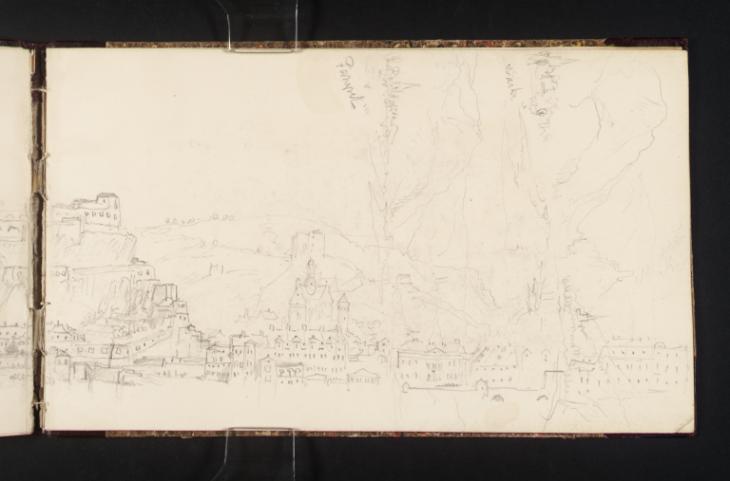Joseph Mallord William Turner The Fortress and Town of Ehrenbreitstein from Coblenz; Beilstein and Burg Metternich, Looking Upstream: from Fankel and from slightly further Downstream 1839
Joseph Mallord William Turner,
The Fortress and Town of Ehrenbreitstein from Coblenz; Beilstein and Burg Metternich, Looking Upstream: from Fankel and from slightly further Downstream
1839
Joseph Mallord William Turner 1775–1851
Folio 6 Verso:
The Fortress and Town of Ehrenbreitstein from Coblenz; Beilstein and Burg Metternich, Looking Upstream: from Fankel and from slightly further Downstream 1839
D28302
Turner Bequest CCLXXXIX 6 a
Turner Bequest CCLXXXIX 6 a
Pencil on white wove drawing paper, 140 x 235 mm
Inscribed in pencil by Turner ‘Washing’ and ‘Fangels’
Inscribed in pencil by Turner ‘Washing’ and ‘Fangels’
Accepted by the nation as part of the Turner Bequest 1856
Exhibition history
1964
Ruskin and his Circle, Arts Council Gallery, London, January–February 1964 (103).
1991
Turner’s Rivers of Europe: The Rhine, Meuse and Mosel, Tate Gallery, London, September 1991–January 1992, Musée Communal d’Ixelles, Brussels, February–April 1992 (44, reproduced).
References
1909
A.J. Finberg, A Complete Inventory of the Drawings of the Turner Bequest, London 1909, vol.II, p.922, as ‘Ehrenbreitstein, from the Coblenz side’.
1964
Kenneth Clark, Elizabeth Davidson and John Gage, Ruskin and his Circle, exhibition catalogue, Arts Council Gallery, London 1964, p.30 no.103.
1991
Cecilia Powell, Turner’s Rivers of Europe: The Rhine, Meuse and Mosel, exhibition catalogue, Tate Gallery, London 1991, pp.128 no.44, 150 no.82, Appendix, pp.218–20.
1995
Cecilia Powell, Turner in Germany, exhibition catalogue, Tate Gallery, London 1995, pp. 63, note 14, [p.81, compare no.19], 104 fig.19.1.
This view of the town and fortress of Ehrenbreitstein is the single largest and most developed of any sketch taken by Turner during his 1839 tour of the Meuse-Moselle region. The prospect is expansive and highly detailed, continuing onto the folio opposite (Tate D28303; Turner Bequest CCLXXXIX 7) to offer the viewer a comprehensive and almost itemised impression of Ehrenbreitstein’s topography and architecture. This rewardingly descriptive drawing was, it seems, produced in and for itself. It did not form the basis of a finished gouache drawing, as other of the 1839 Meuse-Moselle pencil sketches had done.
Turner took the view from a vantage point on the opposite bank of the Rhine, on a landing stage at Koblenz. He orientated the drawing inversely relative to the foliation. As the art historian Cecilia Powell points out, the horizontal format of this sketchbook was particularly suitable for capturing the vast extent of the fortress.1
By the time of Turner’s visit in 1839 the Festung Ehrenbreitstein had undergone great changes. It had been severely damaged by Napoleonic armies at the turn of the century as a result of repeated sieges and occupations. But with the return of peace in 1815, the Prussians began to demolish and later to rebuild the citadel to even grander proportions. The new fortress was completed in the first years of the 1830s and stocked, as Powell writes, with ‘400 pieces of heavy ordnance on its ramparts, cisterns with enough fresh water for a three-year siege, stores with sufficient provisions to feed 8,000 men for ten years’ and estimated to be ‘capable of housing an army of 100,000’.2 The magnitude and impenetrability of Ehrenbreitstein is certainly suggested in this drawing, but it appears perhaps a little less forbidding than Turner’s depiction of the fortress during its demolition in 1817 (Tate impression: T06067).
The viewer will notice that part of Ehrenbreitstein fortress has been drawn over with two landscapes of Beilstein and the Burg Metternich. Executed in light and tentative line, Turner has inscribed the drawings ‘Fangles’ (for Fankel, the town which neighbours Beilstein) and ‘Washing’, presumably to signify the washing of textiles at the water’s edge. The Burg Metternich, seen in profile atop a mount in the distance in one of the sketches, is a ruined medieval fortress which was once ‘the property of the Electors of Trèves, but was held for them by the noble vassals the counts of Matternich and Winneburg’.3
For further drawings of the Burg Metternich in this sketchbook see Tate D28320, D28321; Turner Bequest CCLXXXIX 15a, 16; see also the 1839 Trèves to Cochem and Coblenz to Mayence sketchbook (Tate D28364–D28368, D28527, D28528, D28537; Turner Bequest CCXC 7a–9a, 86a, 87, 91a) and the 1839 gouache and watercolour drawing of the Burg (Tate D20239; Turner Bequest CCXXI F). For earlier sketches of the monument see the Rivers Meuse and Moselle and Moselle (or Rhine) sketchbooks of 1824 (Tate D19784, D19787, D19788, D19790, D19792, D20166, D20167; Turner Bequest CCXVI 117, 118a, 119, 120, 121, CCXIX 5, 6).
Alice Rylance-Watson
August 2013
How to cite
Alice Rylance-Watson, ‘The Fortress and Town of Ehrenbreitstein from Coblenz; Beilstein and Burg Metternich, Looking Upstream: from Fankel and from slightly further Downstream 1839 by Joseph Mallord William Turner’, catalogue entry, August 2013, in David Blayney Brown (ed.), J.M.W. Turner: Sketchbooks, Drawings and Watercolours, Tate Research Publication, November 2014, https://www

